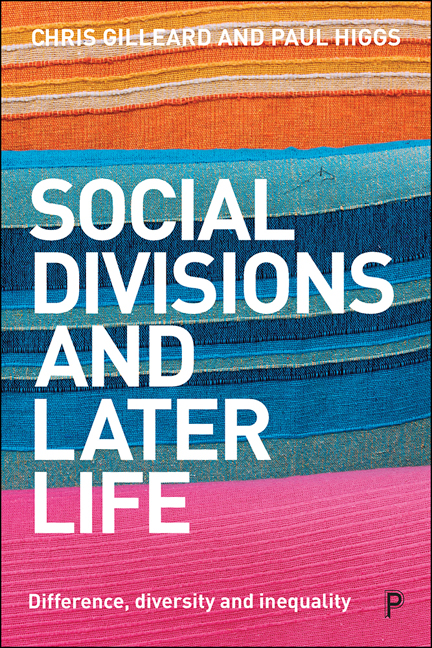Book contents
- Frontmatter
- Contents
- List of Figures and Tables
- Preface
- 1 Social Divisions and Social Differences
- 2 Social Class and Inequality in Later Life
- 3 Ageing and Gender
- 4 Ethnicity, Race and Migration in Later Life
- 5 Disability and Later Life
- 6 Identity and Intersectionality
- 7 Diversity, Difference and Division in Later Life
- References
- Index
6 - Identity and Intersectionality
Published online by Cambridge University Press: 25 February 2021
- Frontmatter
- Contents
- List of Figures and Tables
- Preface
- 1 Social Divisions and Social Differences
- 2 Social Class and Inequality in Later Life
- 3 Ageing and Gender
- 4 Ethnicity, Race and Migration in Later Life
- 5 Disability and Later Life
- 6 Identity and Intersectionality
- 7 Diversity, Difference and Division in Later Life
- References
- Index
Summary
Previous chapters have explored the ‘traditional’ social divisions of later life, namely social class, gender, ethnicity/race and disability. It has been argued that each has acquired a greater salience in the study of ageing in large part because of the expansion and diversification of later life itself. Each in their own way has served as both cause and effect in realising the ‘new ageing’ (Gergen and Gergen, 2000). Unsurprisingly their impact is most noticeable among recently retired cohorts of ‘baby boomers’ where difference, diversity and inequality are all more notable. Members of the oldest cohorts, by contrast, are less differentiated and less unequal, both in the diversity of their assets and resources and in the cultural habitus that have shaped their later lifestyles. Hence, the later lives of the baby-boomer cohorts define the contours of the new ageing more closely as they are more extensively engaged with the ‘cultures of the third age’ (Gilleard and Higgs, 2009). No doubt this will become even more evident as the cohort of the ‘late’ boomers, those born in the 1960s, reach retirement age. For now, however, those cohorts born in the 1940s and 1950s provide the principal arena where the social divisions of later life are most evident and whose consumer habitus continue to expand.
The social divides that we have considered central to this diversification of later life reflect (albeit in a somewhat reified form) many of the social differences, distinctions, identities and inequalities that render contextual the experiences and opportunities that constitute third age culture. This chapter shifts attention away from the sources of such broad social categorisation that have so far been addressed – of able-bodiedness, class, ethnicity, gender and race – towards a more general consideration of how the various social locations of later life are both crossed and realised by the intersections between them. In doing so, the aim is particularly to highlight the role played by the ‘new’ social movements not least in ‘queering’ the traditional territory of social divisions with their unmarked and essentialised binary oppositions. Issues of structure and subjectivity that were once central to Marxist approaches to class are now being raised afresh, in the distinction between divisions consciously acknowledged as social identities (or locations) and divisions that are neither acknowledged nor even recognised as identities or locations but which nevertheless serve to structure difference in people's later lives (Moran, 2018).
- Type
- Chapter
- Information
- Social Divisions and Later LifeDifference, Diversity and Inequality, pp. 123 - 140Publisher: Bristol University PressPrint publication year: 2020



